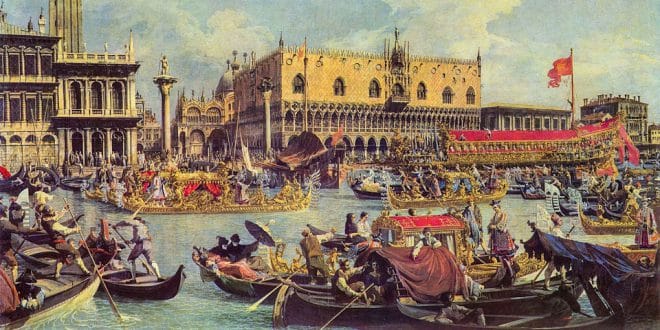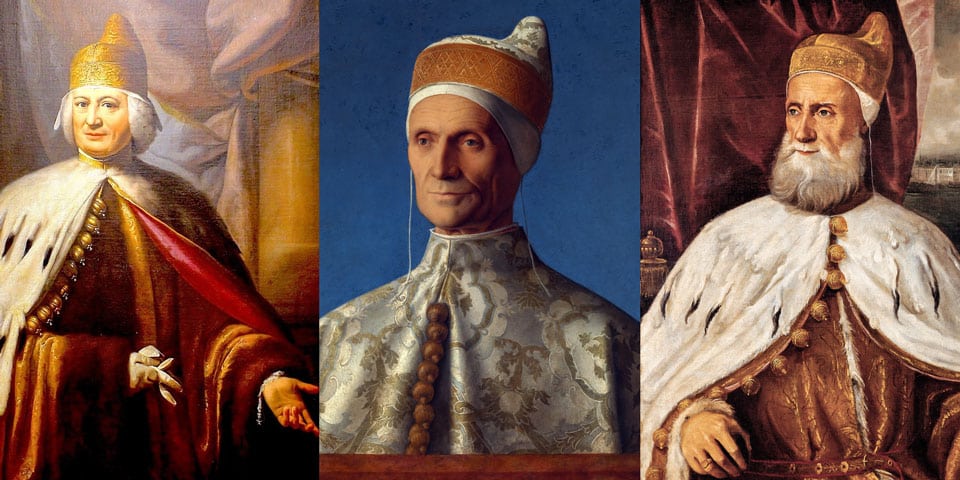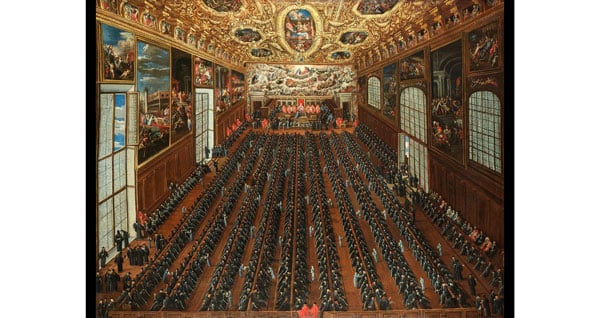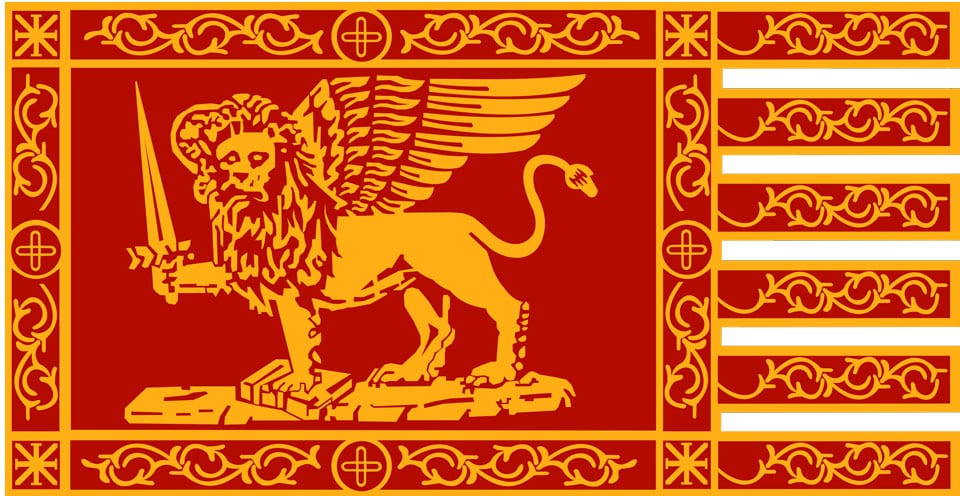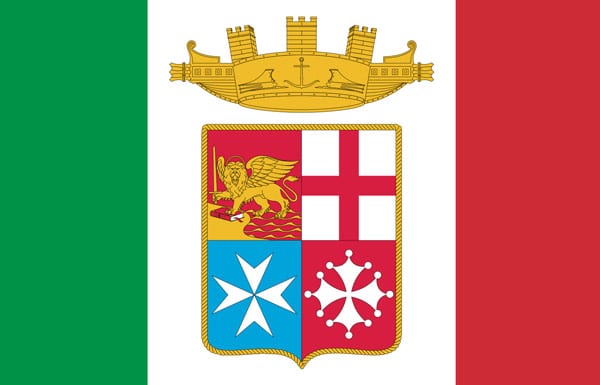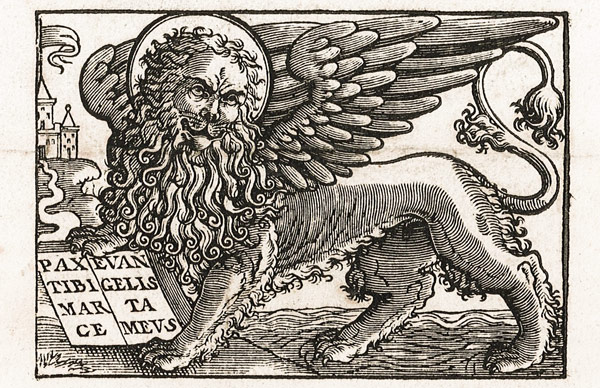Venice (Venezia) is one of the most popular tourist destinations in the world. The brightest and most colorful epithets cannot describe the fabulous, unique atmosphere of the “city of canals.” The fantastic architectural look and masterpieces of sculpture and painting draw millions of tourists from all over the world every year. So for that reason, every traveler should find out about the fascinating and in many ways unique history of the Republic of Venice.
Page Contents
What was on the site of Venice in Antiquity?
In the 2nd century B.C., the mighty Roman Empire conquered the territories in the north of modern-day Italy. Ancient Venetian people populated the lands near the Adriatic Sea (mare Adriatico). In 183-181 BC, Roman colonizers founded the city of Aquileia. It later became the administrative center of the province of Venetia. At the beginning of V century the Roman Empire fell, and the prosperous region was conquered and ruined by the ancient Germanic tribes.
Some inhabitants of Aquileia fled from the barbarians to Grado, some moved west to the deserted islands of the Laguna di Venezia and founded there the city of the same name. In the new place, the settlers fought the sea for every scrap of land: they tamed the water element by building embankments, canals and dykes. They were engaged in fishing and salt mining here.
Due to its isolated position, the “city on the water” escaped the fate of the mainland settlements. While the Lombards, Huns and Ostgoths attacked the inhabitants of the Western Roman Empire, Venice strengthened its position by developing its trade and navy.
In the 6th century, it became one of the most important regions on the Adriatic and provided powerful assistance to the Byzantine ruler in the war against the ancient Germanic tribes. In gratitude, the Eastern Roman Empire provided trade benefits to Venice and took the region under its protection from external enemies. Thus, the “queen of the Adriatic” formally passed into the jurisdiction of Byzantium, united with it by common political interests.
History of the Republic of Venice
The Serenissima Repubblica di Venezia acquired the features of an independent state at the end of the VII century. As the legend says, in 697 the lagoon’s inhabitants elected their first official ruler, the so-called Doge.
The head of the Republic was Paolo Lucio Anafesto, who received the high title with the approval of the Byzantine emperor. Over time, the city-state acquired the desired autonomy. The Treaty of Nicefort, signed in 814, established the borders of Byzantium and the Frankish Empire, which was the starting point for determining the independent status of Venice. Twenty-six years later, the Republic of St. Mark achieved full self-government.
I advise reading about the Doge’s Palace and the most beautiful palaces in Venice.
At the same time, its land position grew stronger: by the fifteenth and sixteenth centuries Venice had conquered the neighboring continental territories. The provinces of Padua, Vicenza, Bassano, Feltre, Belluno, Verona and many others were controlled by the public authorities of the Republic of St. Mark and brought considerable revenue to its coffers.
The conquered land went down in history as terra ferma, Latin for “hard land. Thus, the land borders of Venice extended from the Greek islands of the Aegean Sea to the entire Adriatic coast of northeastern Italy, stretching from the Po River to the Alps. The Republic of St. Mark of the 15th century was a powerful and prosperous state with advanced trade and industry, a prosperous citizenry, and a rich scientific and cultural heritage.
Since the end of the 16th century, Venice was no longer a leading power threatening its neighbors, yielding the palm to the states of Central Europe. The Republic of Venice lost much of its former greatness because of nearly 300 years of devastating wars with the Ottoman Empire, which deprived the Republic of St. Mark of most of its colonies. Another factor that undermined economic prosperity was the opening of the trade route to India by the Portuguese.
With the emergence of the New World on the world map, the main center of commerce became the Atlantic Ocean rather than the Mediterranean. Despite the political and financial crisis, the Republic of Venice remained an independent state with its sovereignty intact.
The French Revolution heralded the collapse of the once mighty power. In 1797, Napoleon Bonaparte’s army captured the “city of canals. The Serene Republic of Venice shamefully capitulated, surrendering to the conqueror almost without a fight. The reigning Doge Ludovico IV Giovanni Manin abdicated power, going down in history as the last head of state. The lands of the Republic of St. Mark were divided between Austria and France, and in 1866, after a period of deep depression, Venice became part of the Kingdom of Italy.
Read more about Venetian Doges.
System of the government in the Republic of Venice
The first body of government was created in 466, when the residents of the Venetian Lagoon elected a council of twelve representatives from each group of islands by ballot.
The Serene Republic of Venice existed for nearly 1100 years, during which time it remained a democratic state, with the aristocracy as the main ruling force, and the principle of electability was unshakable.
The basic institutions of power were finally formed at the end of the thirteenth century, and remained unchanged from then until the fall of the empire, impressing contemporaries by their steadfastness. The Venetian patricians were present in all the administrative organs of the Republic. The tenure of officials was strictly limited, and most decisions were taken collegially. Only the offices of supreme judges and the Doge were for life.
Election of the head
The Great Council
The main governmental body was the Great Council (Maggior Consiglio) where only those from the richest and most influential Venetian families could enter.
By the end of the XV century there were more than 2,500 people in it. This body exercised control over the Doge’s activities, elected senators and other representatives of power. The members of the Grand Council determined the military, financial and fiscal policies of the Republic, and ratified laws.
The day-to-day administrative and executive activities of the city-state were in the hands of the 6 “wise men”, who represented each quarter of Venice. This government unit, called the Minor Consiglio, also controlled the doge’s judicial and political steps.
Senate of the Republic
The Senate of the Republic (Senato) was formed in the first quarter of the 13th century. This body was in charge of the army and navy, dealt with diplomatic matters, set the course of foreign policy and had jurisdiction over financial and trade matters. In the XVI century the number of senators was about 300 people.
XV-XVI centuries is the period of formation of the so-called collegiums of ministers. The vast bureaucratic apparatus consisted of 16 specialized departments, each dealing with pressing national issues of the Republic.
Council of Ten
The Council of Ten (Consiglio dei Dieci) was originally formed as the executive body of the Great Council and was responsible for state security. It developed a multidisciplinary police service and investigative apparatus, whose staff included secret agents, informers, and spies.
Some historians believe that the ramified bureaucratic system established in the Republic of St. Mark was one of the causes of the crisis of statehood in the XVIII century.
Flag
The flag of the Republic of Venice, also known as the Standard of St. Mark, remains a recognizable symbol of the city today and is sold as a souvenir to tourists.
The flag depicts a winged lion, an attribute of St. Mark, as he declared the royal dignity of Christ.
There are two versions of the flag:
The first has the lion holding a sword – this version was used in warfare.
Therefore, today the lion with a sword is included in the coat of arms of the Italian Navy (Marina Militare).
And the second version shows a lion with an open book on which is written in Latin PAX TIBI MARCE EVANGELISTA MEVS – part of the phrase that Mark heard from an angel during a visit to Venice in the first century, it means “Peace to you, Mark, my evangelist”.
John Norwich’s book on the Republic of Venice
The vivid destiny of the “city of canals” has always been of great interest to researchers. The book History of the Republic of Venice, by the Briton John Norwich, is among the most popular printed works on the subject.
By the author’s own admission, every word of it was based on numerous sources collected from the London Library. The historical essay, presented in a very comprehensible and entertaining form, does indeed gather a wealth of interesting details and facts about the political and military life of the Republic of St. Mark.
Must Read: My Favorite Books on Rome and Italy
Interesting Facts about the Republic of Venice
- The Republic of Venice was founded in 697 AD and lasted until its fall in 1797, making it one of the longest-lasting republics in history.
- Venice was built on a network of 118 islands in the Venetian Lagoon, connected by canals and bridges. It became a major maritime and trading power, controlling trade routes between Europe and the East.
- The Venetian Arsenal, established in the 12th century, was the largest industrial complex in medieval Europe. It produced warships and played a crucial role in the naval dominance of Venice.
- The city of Venice was known for its iconic architecture, including the magnificent St. Mark’s Basilica and the elaborate Gothic-style Doge’s Palace. These structures showcased the wealth and grandeur of the republic.
- The Venetian Republic had a unique political system. The Doge, elected for life, served as the ceremonial head of state, while the Great Council represented the aristocracy. The republic had a complex system of checks and balances to prevent the concentration of power.
- The Venetian Republic played a significant role in the development of Renaissance art and culture. It was home to renowned artists such as Titian, Tintoretto, and Giovanni Bellini, and the republic’s patronage of the arts left a lasting legacy.
- Venice was known for its elaborate and extravagant festivals, including the annual Carnival of Venice. The carnival featured masked balls, processions, and street performances, attracting visitors from all over Europe.
 Italy for me From Italy with love
Italy for me From Italy with love

